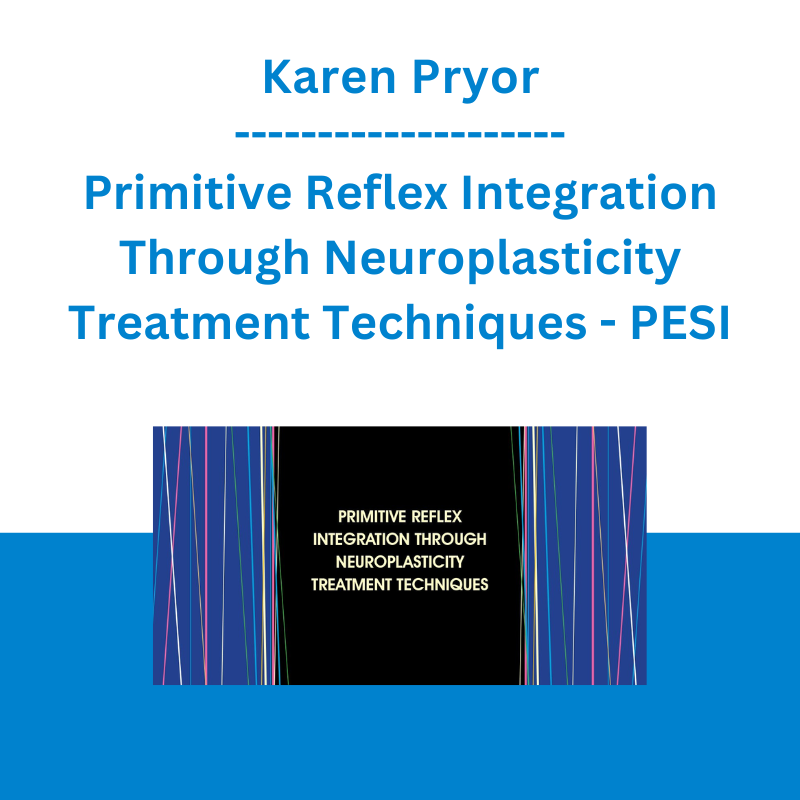*** Proof of Product ***
Exploring the Essential Features of “Karen Pryor – Primitive Reflex Integration Through Neuroplasticity Treatment Techniques – PESI”
Speaker: Karen Pryor, PhD, PT, DPT, CH, CFPS
Duration: 1 Hour 54 Minutes
Format: Audio and Video
Copyright: Jul 30, 2020
Media Type: Digital Seminar
Description
Therapists frequently see primitive reflex patterns in pediatric cases. Sensory experiences govern primitive reflexes. When treatment is directed around the level of the lesion, integration begins. Rather than management of symptoms alone, neuroplasticity provides effective tools to place primitive reflex patterns in the background of the nervous system, allowing more voluntary movement.
Speaker
Karen Pryor, PhD, PT, DPT, CH, CFPS
Health Sphere Wellness Center
Karen Pryor, PhD, PT, DPT, CH, CFPS, has a doctorate in physical therapy and has practiced for 40 years in the field. Dr. Pryor is the owner of Health Sphere Wellness Center, an integrative therapy clinic in Nashville, Tennessee. Involved with early intervention in the birth-three population for over 30 years, she has developed neuroplasticity techniques that are used in a wide variety of settings, including homes, childcare centers, and school systems, to advanced pediatric therapy programs. Dr. Pryor serves on several boards, including the Leadership Interagency Council for Early Intervention (2014-2019), a position to which she was appointed by Tennessee Governor Bill Haslam. In 2010, she received the President’s Volunteer Service Award for her contributions to the advanced treatment of children from President Barack Obama. In addition to her work with children, Dr. Pryor has served as an adjunct professor at the Tennessee State University Occupational Therapy Assistant program. She is a clinical instructor for several universities and colleges. With her years of experience and passion for complete wellness, Dr. Pryor advances a more expansive view of how to integrate therapy throughout the lifespan by using neuroplasticity techniques.
Speaker Disclosures:
Financial: Karen Pryor is the owner of Health Sphere Wellness Center, LLC and is a field examiner for PDMS-3. She has employment relationships with Tennessee State University, University of Tennessee at Chattanooga Physical Therapy School, Daymar Physical Therapy Assistant School and Volunteer State Community College. Karen Pryor receives a speaking honorarium and recording royalties from PESI, Inc. She has no relevant financial relationships with ineligible organizations.
Non-financial: Karen Pryor is a reviewer with Tennessee Physical Therapy Association and American Physical Therapy Association. She is an Ambassador for National Down Syndrome Society.
Objectives
- Distinguish where and why spastic patterns are demonstrated and how to apply neuroplasticity techniques
- Assess the neurological system of the pediatric patient to form a basis of therapeutic neuromotor rewiring around damaged areas
- Determine how to treat with neuroplasticity techniques to decrease the tone of spastic patterns to allow active movements
Outline
Function Related to Neurological Anatomy
- Brain and brain stem anatomy
- CNS lobes and layers related to function
- Why spastic patterns are demonstrated
- How to apply neuroplasticity techniques
Neurological System of the Pediatric Patient
- Neurological damage effects relating to specific regions of the brain and brain stem
- Instruction related to specific area of the CNS
- Demonstration of neurological patterns
- Form a basis of therapeutic neuromotor rewiring around damaged areas
Change Connections in the CNS
- Target brain regions to treat
- Neuroplasticity techniques to decrease the tone of spastic patterns and allow active movements
- Relate simple treatments for use in home programs
Target Audience
- Physical Therapists
- Occupational Therapists
- Athletic Trainers
- Speech/Language Pathologist
Please see the full list of alternative group-buy courses available here: https://lunacourse.com/shop/










 Toshko Raychev - Profit System + ITF Assistant
Toshko Raychev - Profit System + ITF Assistant  The Daily Traders – Exclusive Trading Mentorship Group
The Daily Traders – Exclusive Trading Mentorship Group  Miranda Macpherson - Embodying Grace in Times of Challenge - The Shift Network
Miranda Macpherson - Embodying Grace in Times of Challenge - The Shift Network  Dave Landry - Stock Selection Course
Dave Landry - Stock Selection Course  Fred Haug - Virtual Wholesaling Simplified
Fred Haug - Virtual Wholesaling Simplified  Julie Stoian & Cathy Olson - Launch Gorgeous - Funnel Gorgeous Bundle
Julie Stoian & Cathy Olson - Launch Gorgeous - Funnel Gorgeous Bundle  Alphashark - The AlphaShark SV-Scalper
Alphashark - The AlphaShark SV-Scalper